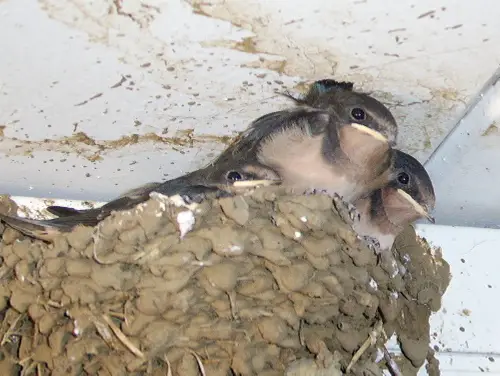
Here your airy nest you build;
And, when bright days cease to smile,
Fly to Memphis or the Nile”
– Jacob Henry Studer, 1840-1904, “Birds of North America” (1903)
Once caught by the thousands to be used in women’s hats, eating insects literally on the fly, and returning year after year to the same nesting sites, the American barn swallow is one of the harbingers of summer. A beautiful low-flying bird, I always look forward to the spring nesting ritual and the summer babies emerging from the nest.
The barn swallow is also the species the slaughter of which aroused in the mind of George Bird Grinnell such indignation that he wrote a vigorous article in 1886 on the incredible waste of bird life for millinery. That of course soon led to the founding of the first Audubon Society.
On the farm the comings and goings of the barn swallow is as familiar as the clucking of the hen or the challenge of the rooster, albeit a bit more melodious though no less beneficial.
Reportedly this species eats 70 percent of its diet in large flies, and having them around a farm or any other area that is prone to large populations of unwanted flying insects is immensely useful.
When they forage they fly low to the ground with their mouth wide open “catching” flies, mosquitoes, moths and other insects. Not one to allow an opportunity to go by they often will get an easy feed by following the tractor out in the field to “catch” the insects the tractor dusts up.
The barn swallow is a very cosmopolitan bird, having the widest distribution of all the swallows, with different subspecies nesting in North America, Europe and Asia.
Being a long distance migrant, they adjust to the seasons so that they can follow the warmth. In western North America they summer from the southern parts of Alaska to the central parts of Mexico, and they winter from south Mexico to the lowland portions of South America.
Their Latin name (Hirundo rustica) literally means “swallow of the country” so of course they are usually found in open habitats such as marshes, lakeshores, fields and farms. Their nests are typically a cup or funnel made of mud, clay, grass and plant stems.
In today’s world they tend to attach the nest to the side of a wall or on top of a ledge, and they prefer old comfortable barns with open rafters that make it easy for them to get in and out of while providing needed shelter. Before barns they would have resorted to nesting in the caves and crags found in the natural world but they have adapted well to human structures.
Female barn swallows lay between three to seven eggs, which are of a creamy white color marked with dark brown.
Watch out if you are around a barn swallow nest, for they will defend it by swooping down and around any creature great or small that comes near the nest.
Both parents assist in the incubation, which lasts about two weeks, and once the eggs have hatched both parents take care of the young. After about three weeks the young will leave the nest.
A monogamous yet social bird species, barn wwallows tend to occur in small flocks and are often seen perching in a row atop a power line or fence.
The song of the barn swallow is a cheerful warble, but I can always tell when the barn cat is around for their call sharpens and quickens.
The barn swallow is a common bird, found abundantly across the state. They are protected under the Federal Migratory Bird Treaty Act of 1918, but as the plight of the passenger pigeon reminds us, just because a bird is abundant doesn’t mean it is safe.
Climate change may affect them in a variety of ways. Any drought can cause weight loss and slow feather regrowth, and hot dry summers will reduce the availability of insect food for chicks.
Many aspects of their ecology may also be affected by climate change, such as earlier springs that may cause some birds to migrate earlier due to the warmer temperatures.
As the saying goes, “One swallow doesn’t make a summer.” I do hope our beautiful guests of the summer will remain abundant for many generations to come.
Debra Chase is the executive director of Tuleyome, a local nonprofit working to protect both our wild heritage and our agricultural heritage for future generations. She resides on a small family farm in Colusa County. Visit the group online at www.tuleyome.org .
